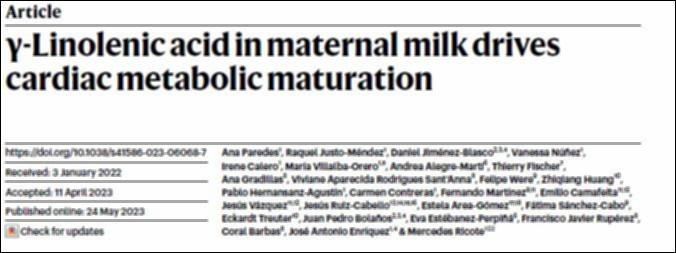Por favor, use este identificador para citar o enlazar este ítem:
http://hdl.handle.net/10637/15014γ-Linolenic acid in maternal milk drives cardiac metabolic maturation

Ver/Abrir:
γ-Linolenic_2023.JPG
48,96 kB
JPEG
Ver/Abrir:
γ-Linolenic_Paredes_et_al_Nature_2023.pdf
Acceso restringido
8,84 MB
Adobe PDF
Request a copy
Ver/Abrir:
Correction_γ-Linolenic_Paredes_Nature_2023.pdf
600,82 kB
Adobe PDF
| Título : | γ-Linolenic acid in maternal milk drives cardiac metabolic maturation |
| Autor : | Paredes, Ana Justo-Méndez, Raquel Jiménez-Blasco, Daniel Núñez, Vanessa Calero, Irene Villalba-Orero, María Alegre-Martí, Andrea Fischer, Thierry Gradillas Nicolás, Ana Aparecida Rodrigues Sant'Anna, Viviane Were, Felipe Huang, Zhiqiang Hernández-Agustín, Pablo Contreras, Carmen Martínez, Fernando Camafeita, Emilio Ruiz Cabello, Jesús Area-Gómez, Estela Sánchez-Cabo, Fátima Treuter, Eckardt Bolaños, Juan Pedro Estébanez-Perpiñá, Eva Rupérez Pascualena, Francisco Javier Barbas Arribas, Coral. Ricote, Mercedes Vázquez, Jesús |
| Materias: | Energy metabolism; Transcription |
| Editorial : | Nature |
| Citación : | Paredes, A., Justo-Méndez, R., Jiménez-Blasco, D. et al. γ-Linolenic acid in maternal milk drives cardiac metabolic maturation. Nature 618, 365–373 (2023). https://doi.org/10.1038/s41586-023-06068-7 |
| Resumen : | Birth presents a metabolic challenge to cardiomyocytes as they reshape fuel preference from glucose to fatty acids for postnatal energy production1,2. This adaptation is triggered in part by post-partum environmental changes3, but the molecules orchestrating cardiomyocyte maturation remain unknown. Here we show that this transition is coordinated by maternally supplied γ-linolenic acid (GLA), an 18:3 omega-6 fatty acid enriched in the maternal milk. GLA binds and activates retinoid X receptors4 (RXRs), ligand-regulated transcription factors that are expressed in cardiomyocytes from embryonic stages. Multifaceted genome-wide analysis revealed that the lack of RXR in embryonic cardiomyocytes caused an aberrant chromatin landscape that prevented the induction of an RXR-dependent gene expression signature controlling mitochondrial fatty acid homeostasis. The ensuing defective metabolic transition featured blunted mitochondrial lipid-derived energy production and enhanced glucose consumption, leading to perinatal cardiac dysfunction and death. Finally, GLA supplementation induced RXR-dependent expression of the mitochondrial fatty acid homeostasis signature in cardiomyocytes, both in vitro and in vivo. Thus, our study identifies the GLA–RXR axis as a key transcriptional regulatory mechanism underlying the maternal control of perinatal cardiac metabolism. |
| Descripción : | 15 June 2023 A Correction to this paper has been published: https://doi.org/10.1038/s41586-023-06316-w |
| URI : | http://hdl.handle.net/10637/15014 |
| Derechos: | http://creativecommons.org/licenses/by-nc-nd/4.0/deed.es |
| ISSN : | 1476-4687 |
| Fecha de publicación : | 24-may-2023 |
| Centro : | Universidad San Pablo-CEU |
| Aparece en las colecciones: | Facultad de Farmacia |
Los ítems de DSpace están protegidos por copyright, con todos los derechos reservados, a menos que se indique lo contrario.

